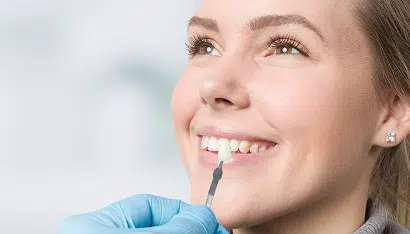One of the most common questions we get asked here at Plaza Dental Mackay is about dental veneers. Dental veneers can provide an excellent cosmetic enhancement and in some cases provide additional strength to worn teeth.
However not all veneers are the same and so in this blog we are going to look at what some of the different types of veneers are.
Veneers can be divided up by material and by the type of tooth preparation used.
Materials
-
Custom Ceramic
Ceramic veneers are the strongest and are the most beautiful veneers that can be made. These are individually made for your teeth, either by technician or in-house using our CEREC milling technology.
These veneers will give you the best aesthetics, the strongest and longest lasting results. However to get this result is more complicated and time-consuming, which makes these most expensive types of veneers. Because these are made outside of the mouth and then bonded in place the teeth typically require some preparation. -
Custom Composite
Composite veneers are built directly onto your teeth either freehand or using a template. These can also give a great result. However the strength and durability is lower than that of ceramic veneers. As these are built directly onto your teeth, these can often be done as minimal or no preparation veneers.
-
Pre-made veneers
This involves using a ready-made veneer which is selected to match the size of the shape of your tooth. These are just then adjusted and bonded to your teeth.
At Plaza Dental, we do not feel that these can provide a consistently high standard of result and therefore we do not offer these as a choice. We only include them here for completeness.
Preparation Type
-
No preparation Veneers
These have become very popular recently as they are a purely additive procedure. This means that in the future they are removed and all your teeth remain intact underneath. There are however only limited cases where these can be used effectively. They are useful for people who have small teeth or slightly retruded teeth, sometimes they can be used in cases where people have gaps between the teeth.
If however you have large teeth or any teeth that are prominent because this is a purely additive process this will make your teeth look even larger and more prominent. In addition if you have sharp edges or corners on your teeth, these will need to be reduced as they provide areas of high stress which weaken the veneers. This is a variation of the no preparation veneer called the minimal prep veneer. -
Prepared Veneers
These are by far the most common type of veneer, especially for porcelain veneers. Advantage of this type of veneer is that they give us a larger range of choices and can often give the best cosmetic result.
These are used when people have normal to large size teeth, crooked or rotated teeth, discoloured teeth or in many other situations where the solution is more complex than purely adding more structure to the teeth.
The preparations are much finer and less invasive than preparations for conventional crowns or most other restoration. They are generally confined to the outer layer of enamel. This is the main downside to this type of veneer in that once tooth structure has been removed it cannot be regrown. This means if you decide in the future if you do not like the veneers you are not able to simply remove the veneers and return to your natural tooth shape.
As you can see from this, what is the best kind of veneer for someone is a complicated topic all, and in some cases veneers may not even be the ideal solution. If you would like to understand more about veneers or if you think that veneers could help you with your smile please call our reception team 07 4942 3272 and they will book a consultation with one of our expert dentists.








Share this post
Facebook Twitter LinkedIn